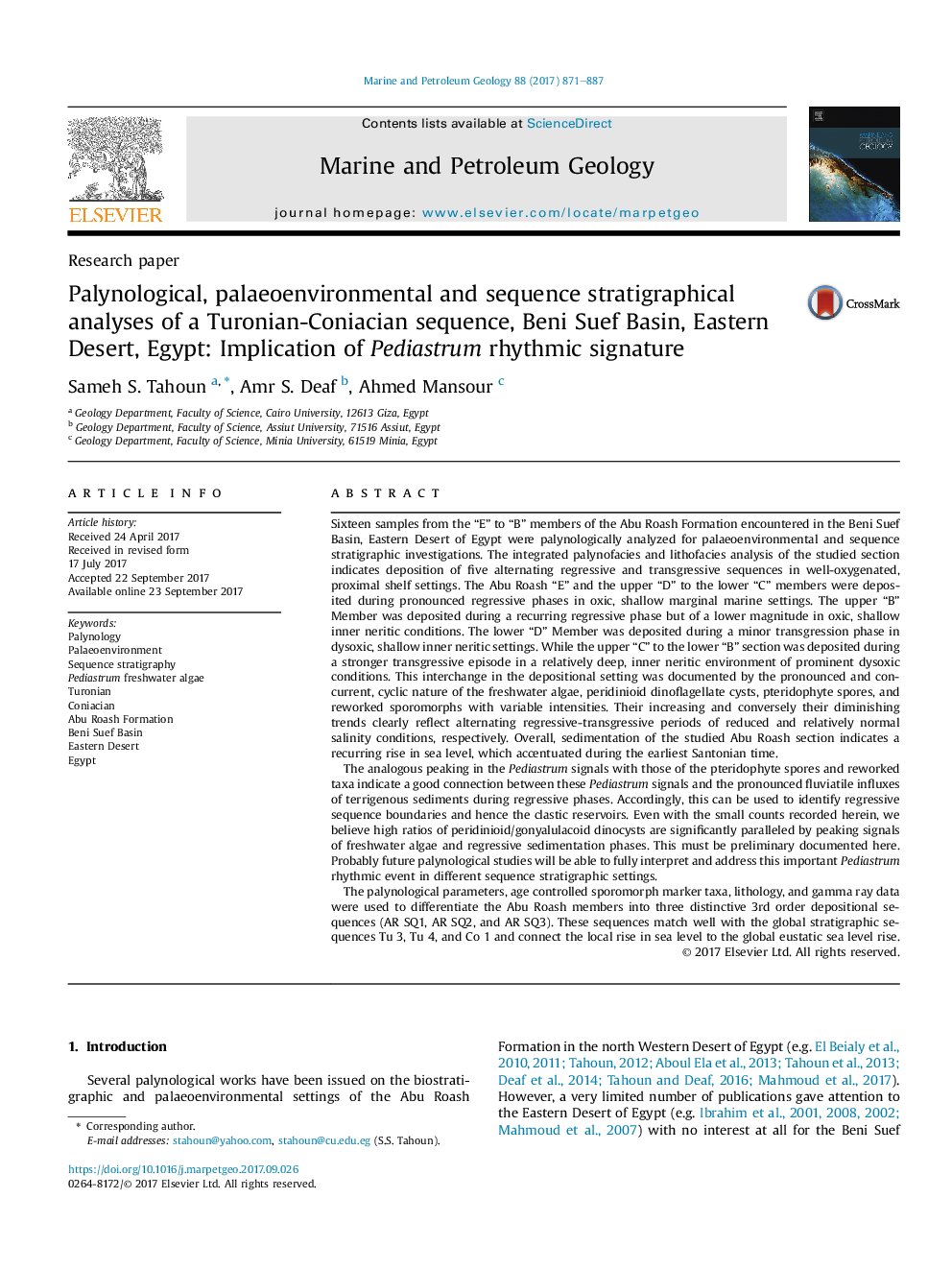| کد مقاله | کد نشریه | سال انتشار | مقاله انگلیسی | نسخه تمام متن |
|---|---|---|---|---|
| 5781944 | 1637139 | 2017 | 17 صفحه PDF | دانلود رایگان |

- Palynologically based paleoenvironmental and sequence stratigraphical interpretations are achieved.
- Integrated palynofacies and lithologic data show deposition of five alternating regressive and transgressive sequences.
- Depositional cyclicity was documented by cyclic freshwater algae, peridinioids, spores, and reworked sporomorphs.
- Preliminary documentation of high peridinioids associated with peaking of freshwater algae.
- Three depositional sequences match with global stratigraphic sequences linking local sea level rise to eustatic one.
Sixteen samples from the “E” to “B” members of the Abu Roash Formation encountered in the Beni Suef Basin, Eastern Desert of Egypt were palynologically analyzed for palaeoenvironmental and sequence stratigraphic investigations. The integrated palynofacies and lithofacies analysis of the studied section indicates deposition of five alternating regressive and transgressive sequences in well-oxygenated, proximal shelf settings. The Abu Roash “E” and the upper “D” to the lower “C” members were deposited during pronounced regressive phases in oxic, shallow marginal marine settings. The upper “B” Member was deposited during a recurring regressive phase but of a lower magnitude in oxic, shallow inner neritic conditions. The lower “D” Member was deposited during a minor transgression phase in dysoxic, shallow inner neritic settings. While the upper “C” to the lower “B” section was deposited during a stronger transgressive episode in a relatively deep, inner neritic environment of prominent dysoxic conditions. This interchange in the depositional setting was documented by the pronounced and concurrent, cyclic nature of the freshwater algae, peridinioid dinoflagellate cysts, pteridophyte spores, and reworked sporomorphs with variable intensities. Their increasing and conversely their diminishing trends clearly reflect alternating regressive-transgressive periods of reduced and relatively normal salinity conditions, respectively. Overall, sedimentation of the studied Abu Roash section indicates a recurring rise in sea level, which accentuated during the earliest Santonian time.The analogous peaking in the Pediastrum signals with those of the pteridophyte spores and reworked taxa indicate a good connection between these Pediastrum signals and the pronounced fluviatile influxes of terrigenous sediments during regressive phases. Accordingly, this can be used to identify regressive sequence boundaries and hence the clastic reservoirs. Even with the small counts recorded herein, we believe high ratios of peridinioid/gonyalulacoid dinocysts are significantly paralleled by peaking signals of freshwater algae and regressive sedimentation phases. This must be preliminary documented here. Probably future palynological studies will be able to fully interpret and address this important Pediastrum rhythmic event in different sequence stratigraphic settings.The palynological parameters, age controlled sporomorph marker taxa, lithology, and gamma ray data were used to differentiate the Abu Roash members into three distinctive 3rd order depositional sequences (AR SQ1, AR SQ2, and AR SQ3). These sequences match well with the global stratigraphic sequences Tu 3, Tu 4, and Co 1 and connect the local rise in sea level to the global eustatic sea level rise.
Journal: Marine and Petroleum Geology - Volume 88, December 2017, Pages 871-887